‘If the wars of the 20th Century were fought over oil, the wars of the 21st century will be fought over water—unless we change our approach to managing this precious and vital resource.’
—Ismail Serageldin
Hydroelectricity is one of the oldest and renewable forms of power generation. Of the total power produced in the world from renewable resources, about 70 per cent is generated through water. This makes up for about 16.6 per cent of the total electricity produced and is expected to increase at the rate of three per cent every year.
For hydroelectricity generation, the kinetic energy of flowing or falling water is used through gravitational force and converted into mechanical energy. This mechanical energy is used to turn turbines, which produces electricity.
As defined by an expert, “A hydraulic turbine converts the energy of flowing water into mechanical energy. A hydroelectric generator converts this mechanical energy into electricity. The operation of a generator is based on the principles discovered by Faraday.
He found that when a magnet is moved past a conductor, it causes electricity to flow. In a large generator, electromagnets are made by circulating direct current through loops of wire wound around stacks of magnetic steel laminations. These are called field poles and are mounted on the perimeter of the rotor. The rotor is attached to the turbine shaft and rotates at a fixed speed. When the rotor turns, it causes the field poles (electromagnets) to move past the conductors mounted in the stator. This, in turn, causes electricity to flow and a voltage to develop at the generator output terminals.”
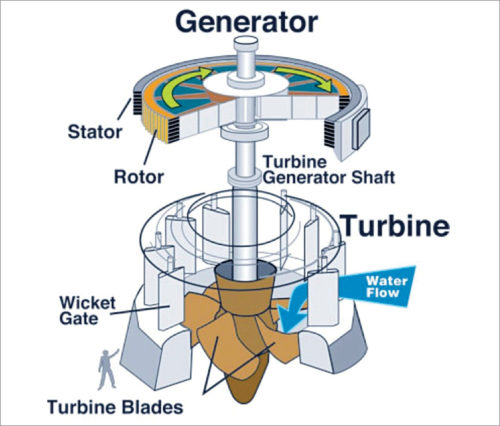
Benefits of hydropower
1. Hydropower is produced using water—a clean fuel source. So unlike power plants that burn fossil fuels such as coal, it does not cause air pollution.
2. Each region with access to a river or any other water body with flowing water is capable of generating its own hydroelectric power.
3. Among all the renewable sources of energy, hydroelectric power makes up for the most cost-effective and reliable power resource. It is recognised and harnessed the most across the world, since the main source of water cycle is sun, which is indestructible.
4. In the process of creating hydroelectricity, normally in dams, reservoirs are created. These reservoirs are often used for commercial activities like fishing and boating.
5. Using the power of turbines, hydropower plants can produce zero to maximum energy output in very less time. Hydroelectric power is therefore used as power backup in disruptions and during emergencies.
6. Manual control over an otherwise naturally free water body like a river can be utilised to solve various problems like water supply, irrigation and flood control as well.
Indian scenario and opportunities
India is one of the major hydroelectric power producers in the Asian region and the seventh largest in the world. As of April 2017, the country’s installed capacity of hydropower generation was around 44,594MW with additional 4280MW from smaller units. The National Hydroelectric Power Corporation (NHPC), Northeast Electric Power Company (NEEPCO), Sutlej Jal Vidyut Nigam (SJVNL), THDC and NTPC Hydro are government bodies responsible for hydroelectric power production in the country and contribute about 92.5 per cent of the total hydroelectric power produced in the country (refer Table I). Of late, private-sector players have also shown interest in the segment and are planning to build power plants in the Himalayan region and Northeast India.
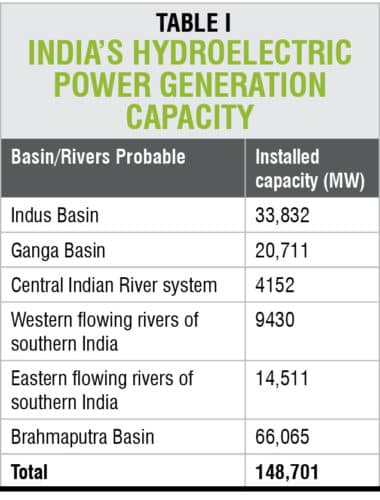
The government is encouraging the private sector to invest in the hydroelectric segment. Currently, private-sector involvement is only about seven per cent. Private-sector participation will lead to revival of stranded projects. To attract investment, the government is looking at various options like land and other subsidies, and waving of taxes and custom duties.
Koteshwar hydroelectric power plant
Built on Bhagirathi, a tributary of the river Ganges, Koteshwar Power Project generates about 400MW electricity. It is one of the quickest project implementations in the nation and has been generating almost 1200GWh energy annually.
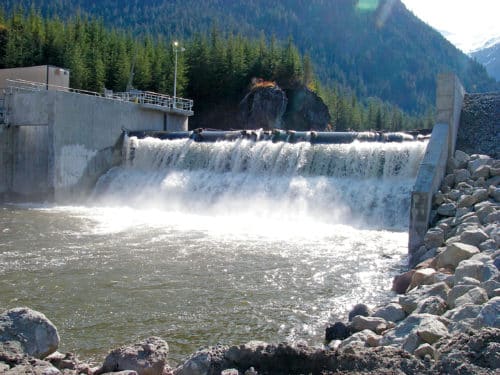
Led by Tehri Hydro Development Corporation (THDC) India with contract offered to PCL-Intertech LenHydro Consortium, the construction work began properly in the year 2007.
Prior to this, a river diversion task was completed in 2003. However, the project came to a halt for the next four years following challenges like exponential rise in the cost of raw material leading to fund insufficiency, difficulty in reaching harmonious conclusions with native population of the region and difficult geographic situations. Despite all odds, the first two power generation units of Koteshwar project were commissioned in 2011 and the two more in 2012, completing the project before the expected deadline.
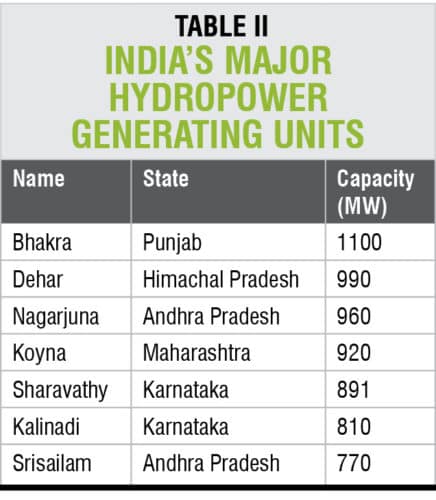 The complete infrastructure of the setup comprises a powerhouse on the right bank of the Bhagirathi river, at the toe of a 97.5-metre high concrete gravity dam. The powerhouses holds the four turbine-power generation units, each having a capacity of 100MW. The generators are semi-umbrella-type vertical shafts connected to a Francis turbine, all manufactured by Bharat Heavy Electricals Limited.
The complete infrastructure of the setup comprises a powerhouse on the right bank of the Bhagirathi river, at the toe of a 97.5-metre high concrete gravity dam. The powerhouses holds the four turbine-power generation units, each having a capacity of 100MW. The generators are semi-umbrella-type vertical shafts connected to a Francis turbine, all manufactured by Bharat Heavy Electricals Limited.
The main reason behind quick completion of the project was changes in managerial procedures and team structures. Time-taking procedures were cut down in the most practical way to ensure quick procurement and construction. In addition, unconventional methods of constructions were implemented as well. For instance, to erect turbines, crawler cranes were used instead of electrical overhead cranes. Alternate approaches were taken to concrete the generator barrels, excavation, service bay creation and accelerate the reservoir filling.
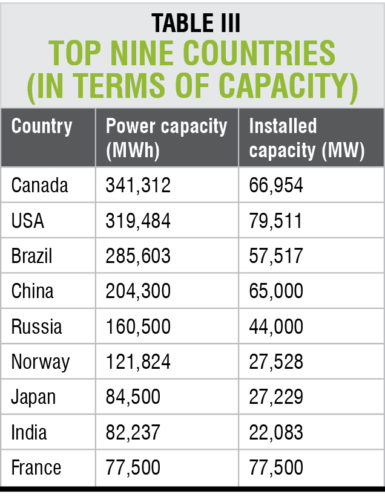
On commissioning the third and fourth units, the hydroelectric plant started running with full power since March 2012. With a total 400MW generation capacity, the annual energy production by the setup is 1155 gigawatt-hour based on 90 per cent available water.
Operational challenges
Harm to the natural environment and significantly high production cost are the major challenges to the growth of hydroelectric power sector. Creating hydropower plants on an already existing dam is a relatively simpler task. However, to create newer infrastructure, one needs to carefully examine the environmental impact. The Uttarakhand flood disaster is regarded as a result of dam construction at an earthquake-volatile piece of land that aggravated the impact of flood. Construction of a hydropower plant is often considered as a threat to wildlife and water species.
The future potential
To take complete advantage of water, we need to properly define the path for hydropower generation. The bureaucratic process of getting the desired approvals discourages private-sector participation. The concerned authorities must ensure minimal environmental impact of hydropower plants and safe rehabilitation. Foreign participation and attractive schemes from concerned authorities will further help in reaping greater benefits.






